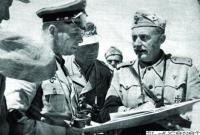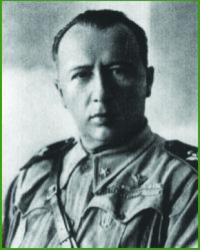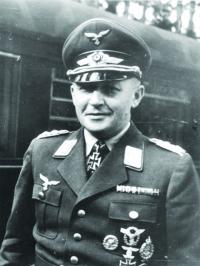This week, 70 years ago, Panzerarmee Afrika and the Eighth Army met for the first time at El Alamein. El Alamein is a tiny railroad station on the Mediterranean Coast, 66 miles west of Alexandria and 149 miles northwest of Cairo, Egypt. Today, it has a population of 7000.
After recapturing Tobruk, Field Marshal Rommel barely paused. By 7:22 p.m. on June 23, less than 36 hours after South African General Hendrik Klopper had surrendered Tobruk, Axis Forces were crossing the Egyptian border 80 miles to the east. Sidi Barrani, 59 miles east of the Libyan border and highwater mark of the Italian invasion of 1940, was recaptured. Today, Sidi Barrani has a population of 14,000.
On June 25, 1941, Sir Claude Auchinleck replaced Eighth Army’s commander, Neil Ritchie, with himself. The next day, Rommel sent 90th Light Afrika, Brescia and Trento Divisions, commanded by, respectively: Ulrich Kleemann; Giacomo Lombardi and Giorgio Masina, against Mersa Matruh, Egypt. Mersa Matruh is located 149 miles west of the Egyptian port of Alexandria on the Mediterranean Sea and was defended by 10th Indian Division, commanded by Major-General T. W. Rees.
That same day, the RAF targeted the Italian XX Motorized Corps’ headquarters, killing its commander Ettore Baldassare and its artillery commander Guido Piacenza. Before his promotion to corps’ commander General Baldassare had commanded the Ariete Armored Division. One of his field artillery lieutenants, Gen. Franco Lo Sardo (ret., Caribinieri), said he was one of the best field commanders in the Italian Army. Field Marshal Rommel described him as, "...a brave and efficient commander." Giuseppe de Stefanis succeeded General Baldassare in command of the XX Motorized Corps.
General Rees had told his superior, XIII Corps’ commander William Gott, that the division couldn’t hold the position. Saying Rees lacked "resolution," Gott replaced him with Major-General John S. Nichols. General Rees was correct, and Mersa Matruh was captured on June 29th by a combined effort of General Kleemann’s 90th Light Division and the Italian X and XXI Infantry Corps, commanded by Benvenuto Gioda and Enea Navarini, together with 6000 prisoners, 40 tanks and an enormous amount of supplies.
But the engagement at Mersa Matruh had bought "The Auk" time to prepare a position at El Alamein. El Alamein is 66 miles west of Alexandria and 149 miles northwest of Cairo. There, in addition to the Mediterranean Sea on the northern flank, the impassable Quattara Depression bounded the southern flank. Only 40 miles separated the two features. No longer was there a wide-open dessert to the south, allowing either army to go around the other. It was here that the Commonwealth Forces prepared to make their stand.
The engagement at Mersa Matruh shook the British administrators in Egypt and thrilled the Egyptians, who looked upon the Axis as liberators. In Cairo, confidential documents were being burned, and defensive positions were prepared around the city and along the Suez Canal, while the Nile delta was flooded.
By now, the exhausted Panzerarmee Afrika was reduced to 55 medium German and 70 obsolete Italian tanks, 330 German and 200 Italian artillery pieces, 15 armored cars and 2000 German and 8000 Italian infantry. But Rommel knew that this was his one opportunity - hit the Eighth Army while it was reeling and demoralized. He felt that if he could, somehow, slip past it, there would be nothing between him and the Canal. But if he were to be stopped, the logistical imbalance would ultimately overwhelm his forces, since now, the "Arsenal of Democracy" was kicking into gear and American-made tanks and planes were beginning to appear in ever greater numbers.
During the first week of July an exhausted and depleted Panzerarmee Afrika was repulsed by an equally exhausted and depleted Eighth Army. The Royal Air Force, flying from its nearby bases in Alexandria, was a significant factor in both the actual fighting and in disrupting the Axis’ long and exposed supply lines. It now had air superiority.
After resting and regrouping, Panzerarmee Afrika struck again on July 9th. It was making good progress until the Eighth Army’s newly arrived 9th Australian Division, commanded by Sir Leslie J. Morshead, hit the recently arrived Italian Sabratha Division, commanded by Mario Soldarelli, hard the next day, capturing 835. Units from General Masina’s Trento Division, together with the elite Bersaglieri, followed by units of the Trieste Division, commanded by Arnaldo Azzi, repaired the damage. General Soldarelli’s Sabratha Division regrouped, and on July 14, counterattacked, knocking the Aussies back a bit. That was followed, three days later by elements of General Masina’s Trento Division, taking 200 prisoners.
To the south, Eighth Army was assaulting Axis positions on Ruweisat Ridge. The Ariete Armored Division, commanded by Francisco Arena and by now down to 1000 soldiers and less than eight tanks, was savaged by the 2nd New Zealand Division commanded by Bernard Freyberg, with a loss of over half its remaining soldiers. It was rescued by the Pavia Division, commanded by Nazzareno Scattaglia, and General Lombardi’s Brescia Division.
The Commonwealth began striking at the weaker Italian divisions. Brescia and Pavia were hit, again, on July 15, and General Lombardi was severely wounded. A counterattack by 15th Panzer, commanded by Gustav von Värst, bagged 2600 Kiwis. Brescia and Pavia Divisions suffered 2000 captured. Two days later it was the turn of General Masina’s Trento, followed by General Azzi’s Trieste, which landed 700 Italians in captivity. On the evening of July 21, the Indians and Kiwis attempted to take Ruweisat Ridge, but the Trieste and Brescia held, and on the morning of the 22nd, 21st Panzer, commanded by Georg von Bismarck, counterattacked, inflicting 1000 casualties and accounting for 132 British tanks captured or destroyed. By now, Panzerarmee Afrika was down to 38 German and 51 Italian tanks as opposed to 173 in 1st Armored Division, alone.
Then the Commonwealth began moving in the south. On July 23rd the Eighth Army launched an assault which was turned back with a loss of 146 tanks and 1400 men. Three days later, "The Auk" launched another poorly organized assault which resulted in 1000 Aussie casualties at the hands of General Masina’s Trento Division.
Slowly, Axis supplies and reinforcements arrived. The 164th Light Afrika Division, commanded by Josef Folttmann, arrived from Crete, together with the Italian Pistoia Division, commanded by Giuseppe Falugi. And since the Axis had listened to Rommel’s "siren song" and decided not to attack Malta, the airborne troops assigned that task were now free. So the new Field Marshal also received the crack Ramcke Parachute Brigade, commanded by Hermann-Bernhard Ramcke, and the tough, highly trained, Italian Folgore Division commanded by Enrico Fratinni.
Field Marshal Rommel ascribed Panzerarmee Afrika’s failure to the collapse of the power of resistance of many Italian formations.
"The duties of comradeship, for me particularly as their Commander-in-Chief, compel me to say unequivocally, that the defeats that the Italian formations suffered at El Alamein in early July, were not the fault of the Italian soldier. The Italian was willing, unselfish and a good soldier, and, considering the conditions under which he served, had always given better than average. There is no doubt that the achievement of every Italian unit, especially of the motorized forces, far surpassed anything that the Italian Army had done for a hundred years. Many Italian Generals and Officers won our admiration, both as men and as soldiers. The cause of the Italian defeat had its roots in the whole Italian Military State and system, in their poor armament and in the general lack of interest in the war by many Italians, both officers and statesmen. This Italian failure frequently prevented the realization of my plans."
The toll for the month of July for each side was 13,000 casualties.
During the first week in August, British Prime Minister, Sir Winston S. Churchill, and the British Chief of the Imperial General Staff, General Alan Brooke, visited Cairo and decided to replace General Auchinleck as Eighth Army Commander with XIII Corps Commander, Lieutenant-General William "Strafer" Gott, and to promote General Sir Harold Alexander to Commander-in-Chief of the Middle East Command.
One of the best things that ever happened to the Allies in North Africa, occurred when Luftwaffe Fighter Ace, Emil Clade, on August 7th, shot down the plane in which General Gott was a passenger, killing the General. It was said of General Gott, "It has not been unknown for a Commander to pass from disaster to disaster, but it is quite without precedent, for any Commander to pass from promotion to promotion as a reward for a succession of disasters."
On August 13th the late General Gott was replaced as Eighth Army’s Commander by acting Lieutenant-General Bernard Law Montgomery. As the Americans would learn, all too soon, "Monty" did not lack for confidence. The story is told that when General Montgomery learned of his appointment, he said, "After having an easy war, things have now got much more difficult." A colleague told him to cheer-up, at which point the General said, "I am not talking about me. I’m talking about Rommel!" Interestingly, General Montgomery kept an oil painting of the German "Desert Fox" in his mobile headquarters.
NEXT WEEK: ROSTOV-ON-THE DON FALLS
Mr. Wimbrow writes from Ocean City, Maryland, where he practices law representing those persons accused of criminal and traffic offenses, and those persons who have suffered a personal injury through no fault of their own. Mr. Wimbrow can be contacted at
wimbrowlaw@gmail.com <mailto:wimbrowlaw@gmail.com>


